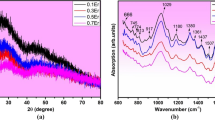Abstract
The crystal structure of Bi2Al4−x Fe x O9 compounds (x = 0–4) has striking similarities with the crystal structure of mullite. A complete substitution of Al by Fe3+ in both octahedral and tetrahedral sites is a particular structural feature. The infrared (IR) spectra of the Bi2M4O9 compounds (M = Al, Fe3+) are characterised by three band groups with band maxima in the 900–800, 800–600 and 600–400 cm−1 region. Based on the spectroscopic results obtained from mullite-type phases, the present study focuses on the composition-dependent analysis of the 900–800 cm−1 band group, which is assigned to Al(Fe3+)–O stretching vibrations of the corner-sharing MO4 tetrahedra. The Bi2Al4O9 and Bi2Fe4O9 endmembers display single bands with maxima centred at 922 and 812 cm−1, respectively. Intermediate Bi2Al4−x Fe x O9 compounds exhibit a distinct splitting into three relatively sharp bands, which is interpreted in terms of ordering effects within the tetrahedral pairs. Thereby the high-energy component band of the band triplet relates to Al–O–Al conjunctions and the low-energy component band to Fe–O–Fe conjunctions. The intermediate band is assigned to stretching vibrations of Al–O–Fe or Fe–O–Al configurations of the corner-sharing tetrahedral pairs. Bands in the 800–600 cm−1 range are assigned to low-energy stretching vibrations of the MO4 tetrahedra and to M–O–M bending vibrations of the tetrahedral pairs. Absorptions in the 600–400 cm−1 range are essentially determined by M–O stretching modes of the M cations in octahedral coordination.






Similar content being viewed by others

References
Abrahams I, Bush AJ, Hawkes GE, Nunes T (1999) Structure and oxide ion conductivity mechanism in Bi2Al4O9 by combined X-ray and high-resolution neutron powder diffraction and 27Al solid state NMR. J Solid State Chem 147:631–636
Beran A, Voll D, Schneider H (2004) IR spectroscopy as a tool for the characterisation of ceramic precursor phases. In: Beran A, Libowitzky E (eds) Spectroscopic methods in mineralogy (EMU notes mineral 6). Eötvös Univ Press, Budapest pp 189–226
Giaquinta DM, Papaefthymiou GC, Loye zur H-C (1995) Structural and magnetic studies of Bi2Fe4−x Al x O9. J Solid State Chem 114:199–205
Nguyen N, Legrain M, Ducouret A, Raveau B (1999) Distribution of Mn3+ and Mn4+ species between octahedral and square pyramidal sites in Bi2Mn4O10-type structure. J Mater Chem 9:731–734
Niizeki N, Wachi M (1968) The crystal structures of Bi2Mn4O10, Bi2Al4O9 and Bi2Fe4O9. Z Kristallogr 127:173–187
Rüscher CH (1996) Phonon spectra of 2:1 mullite in infrared and Raman experiments. Phys Chem Minerals 23:50–55
Rüscher CH (2001) Thermic transformation of sillimanite single crystals to 3:2 mullite plus melt: investigations by polarized IR-reflection micro spectroscopy. J Eur Ceram Soc 21:2463–2469
Schneider H, Komarneni S (2005) Mullite, 2nd edn. Wiley-VCH, New York
Tarte P (1965) Étude expérimentale et interprétation du spectre infra-rouge des silicates et de germanates. Application à des problèmes structuraux relatifs à l’état solide. Acad Royale Belgique, Classe Sci Mémoires 35/4a:1–260
Volkov VV, Egorysheva AV (1996) Photoluminescence in fast-response Bi2Al4O9 and Bi2Ga4O9 oxide scintillators. Opt Mater 5:273–277
Voll D, Lengauer C, Beran A, Schneider H (2001) Infrared band assignment and structural refinement of Al–Si, Al–Ge, and Ga–Ge mullites. Eur J Mineral 13:591–604
Voll D, Angerer P, Beran A, Schneider H (2002) A new assignment of IR vibrational modes in mullite. Vib Spectr 30:237–243
Winter JK, Ghose S (1979) Thermal expansion and high-temperature crystal chemistry of the Al2SiO5 polymorphs. Am Mineral 64:573–586
Zha S, Cheng J, Liu Y, Liu X, Meng G (2002) Electrical properties of pure and Sr-doped Bi2Al4O9 ceramics. Solid State Ion 156:197–200
Acknowledgments
D.V. was supported by the Austrian ‘Fonds zur Förderung der wissenschaftlichen Forschung (FWF)’, project no. P14578-N06.
Author information
Authors and Affiliations
Corresponding author
Rights and permissions
About this article
Cite this article
Voll, D., Beran, A. & Schneider, H. Variation of infrared absorption spectra in the system Bi2Al4−x Fe x O9 (x = 0–4), structurally related to mullite. Phys Chem Minerals 33, 623–628 (2006). https://doi.org/10.1007/s00269-006-0108-8
Received:
Accepted:
Published:
Issue Date:
DOI: https://doi.org/10.1007/s00269-006-0108-8



